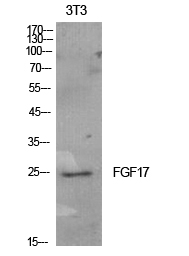FGF-17 Polyclonal Antibody
- Catalog No.:YT5554
- Applications:WB;IHC;IF;ELISA
- Reactivity:Human;Rat;Mouse;
- Target:
- FGF-17
- Fields:
- >>MAPK signaling pathway;>>Ras signaling pathway;>>Rap1 signaling pathway;>>Calcium signaling pathway;>>PI3K-Akt signaling pathway;>>Regulation of actin cytoskeleton;>>Pathways in cancer;>>Chemical carcinogenesis - receptor activation;>>Melanoma;>>Breast cancer;>>Gastric cancer
- Gene Name:
- FGF17
- Protein Name:
- Fibroblast growth factor 17
- Human Gene Id:
- 8822
- Human Swiss Prot No:
- O60258
- Mouse Swiss Prot No:
- P63075
- Immunogen:
- The antiserum was produced against synthesized peptide derived from the C-terminal region of human FGF17. AA range:267-216
- Specificity:
- FGF-17 Polyclonal Antibody detects endogenous levels of FGF-17 protein.
- Formulation:
- Liquid in PBS containing 50% glycerol, 0.5% BSA and 0.02% sodium azide.
- Source:
- Polyclonal, Rabbit,IgG
- Dilution:
- WB 1:500 - 1:2000. IHC: 1:100-1:300. ELISA: 1:10000.. IF 1:50-200
- Purification:
- The antibody was affinity-purified from rabbit antiserum by affinity-chromatography using epitope-specific immunogen.
- Concentration:
- 1 mg/ml
- Storage Stability:
- -15°C to -25°C/1 year(Do not lower than -25°C)
- Other Name:
- FGF17;Fibroblast growth factor 17;FGF-17
- Observed Band(KD):
- 25kD
- Background:
- This gene encodes a member of the fibroblast growth factor (FGF) family. Member of the FGF family possess broad mitogenic and cell survival activities, and are involved in a variety of biological processes including embryonic development cell growth, morphogenesis, tissue repair, tumor growth and invasion. This protein is expressed during embryogenesis and in the adult cerebellum and cortex and may be essential for vascular growth and normal brain development. Mutations in this gene are the cause of hypogonadotropic hypogonadism 20 with or without anosmia. Alternate splicing results in multiple transcript variants. [provided by RefSeq, Jan 2015],
- Function:
- developmental stage:Detected in embryos at E14.5, but not at E10.5 and E19.5. Preferentially expressed in the neuroepithelia of the isthmus and septum of the embryonic brain at E14.5.,function:May be a signaling molecule in the induction and patterning of the embryonic brain.,similarity:Belongs to the heparin-binding growth factors family.,tissue specificity:Preferentially expressed in the embryonic brain.,
- Subcellular Location:
- Secreted.
- Expression:
- Preferentially expressed in the embryonic brain.
TGF-α Overexpression in Breast Cancer Bone Metastasis and Primary Lesions and TGF-α Enhancement of Expression of Procancer Metastasis Cytokines in Bone Marrow Mesenchymal Stem Cells. Biomed Research International Biomed Res Int. 2018;2018:6565393 IHC Human 1 : 100 Breast cancer bone metastasis
- June 19-2018
- WESTERN IMMUNOBLOTTING PROTOCOL
- June 19-2018
- IMMUNOHISTOCHEMISTRY-PARAFFIN PROTOCOL
- June 19-2018
- IMMUNOFLUORESCENCE PROTOCOL
- September 08-2020
- FLOW-CYTOMEYRT-PROTOCOL
- May 20-2022
- Cell-Based ELISA│解您多样本WB检测之困扰
- July 13-2018
- CELL-BASED-ELISA-PROTOCOL-FOR-ACETYL-PROTEIN
- July 13-2018
- CELL-BASED-ELISA-PROTOCOL-FOR-PHOSPHO-PROTEIN
- July 13-2018
- Antibody-FAQs
- Products Images

- Western Blot analysis of NIH-3T3 cells using FGF-17 Polyclonal Antibody. Secondary antibody(catalog#:RS0002) was diluted at 1:20000
.jpg)
- Immunohistochemical analysis of paraffin-embedded human-brain, antibody was diluted at 1:100



